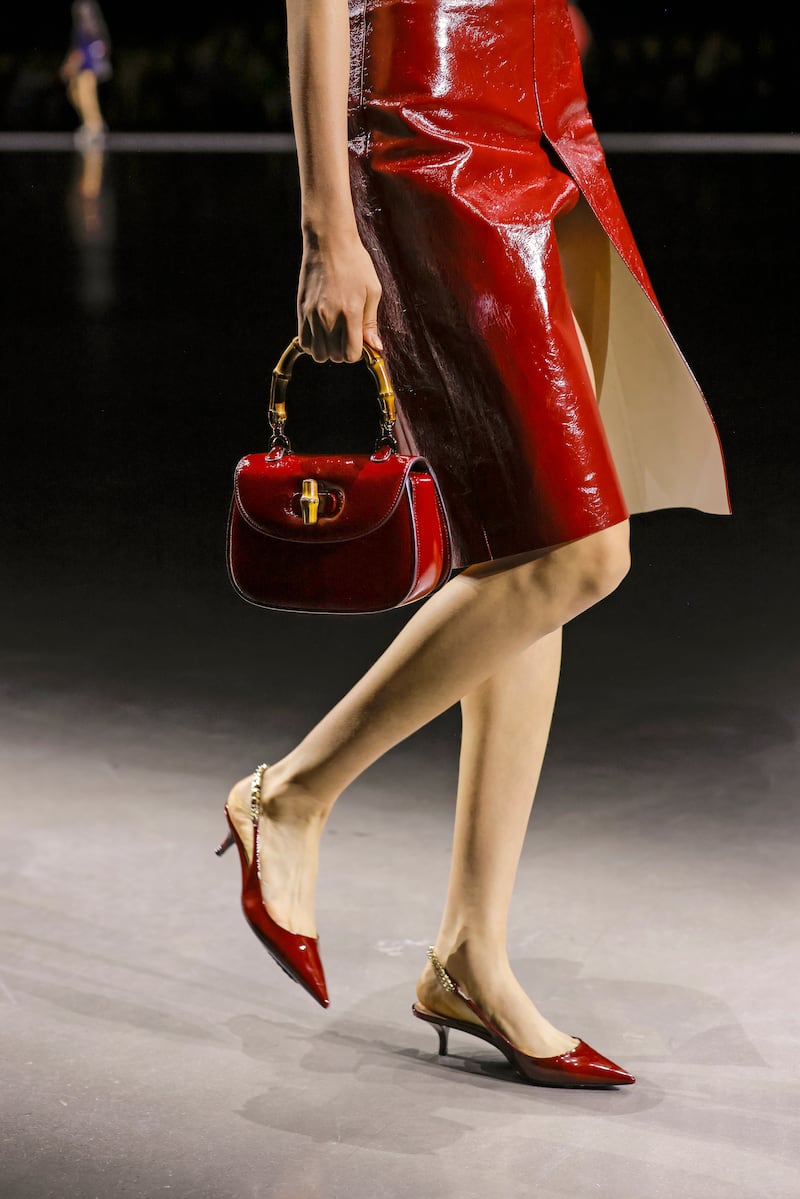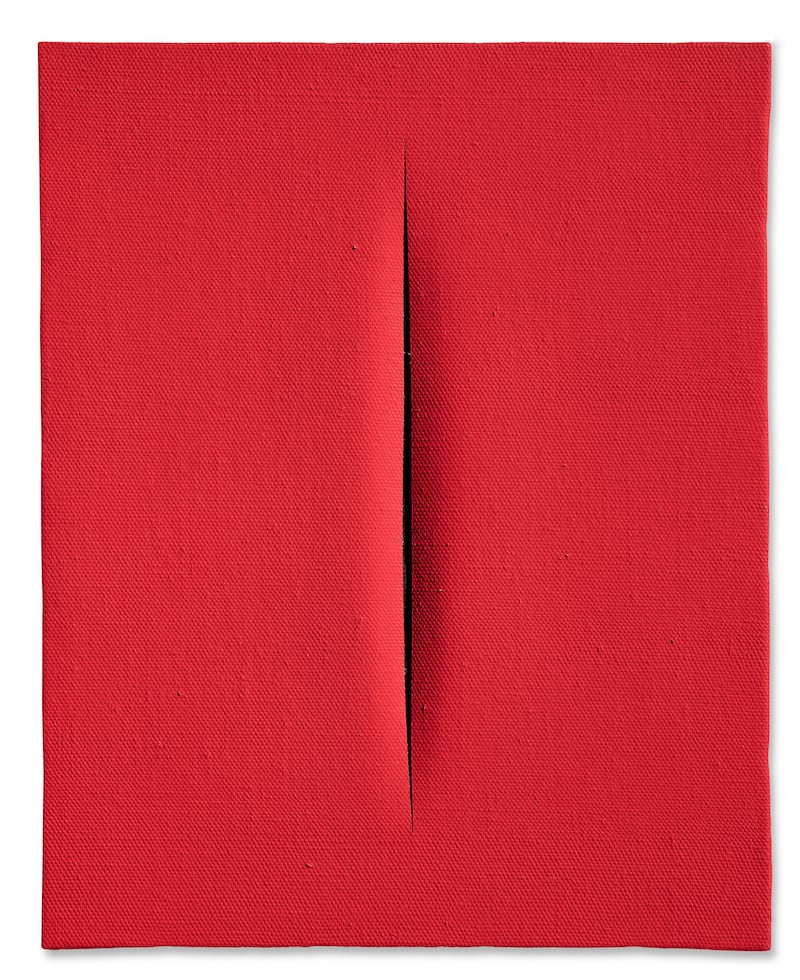
The Business of Fashion
Agenda-setting intelligence, analysis and advice for the global fashion community.

Agenda-setting intelligence, analysis and advice for the global fashion community.

MILAN — Gucci is a girl walking down the street. Young and cool, but not alienating; elegant with an edge.
That message isn’t exactly groundbreaking — but it is a major shift for Gucci, and could prove an effective starting point for Sabato de Sarno, the designer charged with reviving growth at Italy’s biggest fashion brand.
A narrative of youthful, street-smart style came across clearly in De Sarno’s debut show Friday at Milan Fashion Week, despite having to move the proceedings from the buzzing streets of Brera to an unadorned concrete show space under threat of rain.
In his first-ever collection as creative director (he previously designed ready-to-wear collections at Valentino under Pierpaolo Piccioli) De Sarno introduced a core wardrobe that will be easy for contemporary women to imagine themselves wearing.
ADVERTISEMENT
Sartorial, menswear-inspired overcoats were styled with mini-shorts and chunky jewellery, appearing alongside sexy crochet ensembles, sparkling birthday-girl dresses and items as plain as a perfect grey zip-up.
At a brand known for bold aesthetic bets, De Sarno’s biggest provocation was a refusal to feed the attention economy’s appetite for extravagant design. Still, the collection was focused and assertive, debunking speculation that the brand would become the latest to jump on the “quiet luxury” bandwagon (a discourse fuelled by TikTok and a post-pandemic fatigue with overt branding).
Iconic designs that have powered Gucci’s previous growth cycles were still visible, albeit in more muted form than its recent period of logomania. Loafers, bags and GG belts were rendered in an expensive-looking shade of oxblood, which De Sarno plans to grow into a signature hue. The brand’s interlocking G monogram found itself stitched into double-sided jacquard leather, while the stripes from its iconic webbed straps got a nod in a cropped python jacket and matching shorts.
0 of 55
Some investors are now betting the new creative direction will have a real impact on the brand’s fortunes: Shares in the brand’s owner, French group Kering, rose 4.2 percent just after the show, and closed the day up 1.6 percent compared to a 0.4 percent drop in France’s CAC40 index.
Multi-brand buyers, too, seemed enthusiastic about the products even as questions lingered about how Gucci will cultivate buzz around the more low-key offer. The show was a “palate cleanser and reset,” said Holt Renfrew CEO Sebastian Picardo, “The collection offered pieces customers will feel confident investing in, with enough of the Gucci flair to keep them coming back for more.”
Gucci’s sales more than doubled between 2015 and 2019, fuelled by Alessandro Michele’s exuberant designs, innovative digital marketing and decadent merchandising that allowed entry-level shoppers to feel like they were taking home a piece of the designer’s maximalist universe. But the brand took a heavy hit during the pandemic, then climbed back slowly while top rivals like Hermès and LVMH’s Louis Vuitton reported an unprecedented surge. Vuitton, luxury’s biggest brand, has more than doubled its annual turnover to €20 billion since 2018, making it harder for peers to compete for market share.
At the show, Kering chairman François-Henri Pinault sought to manage any lingering expectations of an overnight turnaround at Gucci, the group’s largest brand. “We’re very confident, but we’re doing something that needs to build over time,” he said.
Critical reception of the show was mixed: Most editors granted that De Sarno had nailed the veritas expression of Italian chic he seemed to be going for, but still wondered if he had done enough to challenge or advance that aesthetic.
ADVERTISEMENT
“It was a description of the present. Or perhaps, better, a reaction to the present… De Sarno has built a collection full of clear certainties, of a widespread and reassuring sense of understandable elegance,” fashion writer Andrea Batilla wrote. “The point now is to ask ourselves whether it is right that fashion today has the sole task of describing and no longer imagining alternative worlds, possible ways of rebirth, of change, of resurrection.”
Others wished the designer had expressed a more powerful creative vision. In interviews, De Sarno repeatedly stated the collection was a synthesis of many personal passions, but resisted efforts to tease out what those inspirations were, precisely.
“De Sarno’s fairly safe collection will surely disappoint people. Indeed, the knives were out by dinner,” The Cut’s Cathy Horyn wrote. “I want to give him the benefit of the doubt that he is a pathfinder, and this collection was only the beginning.”

The brand called the collection “Ancora,” evoking Italian singer Mina clamouring for “more, more, more” and the feeling of intense desire De Sarno hoped to inspire. The word also means anchor: he said the collection would serve as a foundation to build on in future seasons. (A few also sensed a potential dig at previous leadership by using a word that also means “again”, perhaps implying that Gucci hadn’t been itself lately. This is an interpretation the brand vigorously denies.)
Commercial Roll-Out
For clients (and sales), the impact of the collection won’t really be felt until February, when the Spring collection arrives in stores. Still, some products are being hurried to production with the aim of doing an early drop as soon as December, company sources said.
In the meantime, the brand plans to focus on reasserting its heritage story and luxe appeal alongside rolling out De Sarno’s vision.
Predecessor Michele and then-CEO Marco Bizzarri worked with merchandisers and marketers to unite a diverse range of consumer tribes under the banner of a maximalist, campy and twisted aesthetic. Now, as younger and less-wealthy consumers tighten their belts, the brand is aiming to project a more stable image. A big marketing push around footwear, particularly the brand’s bread-and-butter loafers, is currently in the works.
ADVERTISEMENT
De Sarno’s collection aimed to complement rather than compete with the heritage drive: The opening look was styled with horsebit loafers (this time on a platform sole), a Jackie bag (the shoulder style popularised in the 1960s by Jacqueline Kennedy Onassis, which the brand has sought to re-energise as a pillar of the business) and GG belt. The opener seemed to wave a red flag at viewers who would malign the collection as too straightforwardly commercial: “Yes, duh, and?”
Exotic materials like python and alligator throughout the collection signalled a continued effort to push the brand’s positioning further upmarket.

At a $10 billion per-year brand, designers are expected to oversee an immersive creative universe: trickling their ideas into myriad touch points from store concepts to social media posts, curating celebrity clients and steering partnerships with other domains in culture.
The lack of an obvious aesthetic world in which to contextualise De Sarno’s show was surely the most commonly voiced objection in the ensuing fashion-week chatter.
The designer may just need time: Not only does the jump from studio designer to creative director entail a huge mindset shift, De Sarno has had to prepare his debut during a sweeping changing of the guard in Gucci’s senior ranks: Longtime marketing and communications chief Robert Triefus left in April, while CEO Marco Bizzarri’s departure was announced in July. Bizzarri has been replaced by Kering’s deputy CEO Jean-François Palus, ostensibly on a temporary basis.
Meanwhile, Triefus’ successor — veteran Gucci executive Susan Chokachi — lasted just a few months in the role. Alessio Vannetti, previously Valentino’s chief brand officer, and before that, Gucci’s worldwide communications director, returned to the brand as executive vice president and chief brand officer just weeks before the show.
To accompany his debut, De Sarno has created a book of key inspirations from the realms of art and photography, partnering with the curator Stefano Collicelli Cagol on a tome juxtaposing works from the mid-20th century through today including Lucio Fontana, Vincenzo Agnetti, Alberto Garutti, Noura Tafeche and more. The volume is set to be rolled out to niche booksellers by publisher Contrasto soon—offering further insights to De Sarno’s world.
New designer Sabato De Sarno is thrown in at the deep end as the brand aims for a turnaround, writes Tim Blanks.
The designer’s first outing this Friday will be a major test for the Italian megabrand and owner Kering.
Luxury’s biggest pre-pandemic success story is reinforcing its high-end credentials as it works to transition from an era of fashion-driven ‘reinvention’ to a new chapter of ‘sustainable elevation.’

Robert Williams is Luxury Editor at the Business of Fashion. He is based in Paris and drives BoF’s coverage of the dynamic luxury fashion sector.
The designer has always been an arch perfectionist, a quality that has been central to his success but which clashes with the demands on creative directors today, writes Imran Amed.
This week, Prada and Miu Miu reported strong sales as LVMH slowed and Kering retreated sharply. In fashion’s so-called “quiet luxury” moment, consumers may care less about whether products have logos and more about what those logos stand for.
The luxury goods maker is seeking pricing harmonisation across the globe, and adjusts prices in different markets to ensure that the company is”fair to all [its] clients everywhere,” CEO Leena Nair said.
Hermes saw Chinese buyers snap up its luxury products as the Kelly bag maker showed its resilience amid a broader slowdown in demand for the sector.